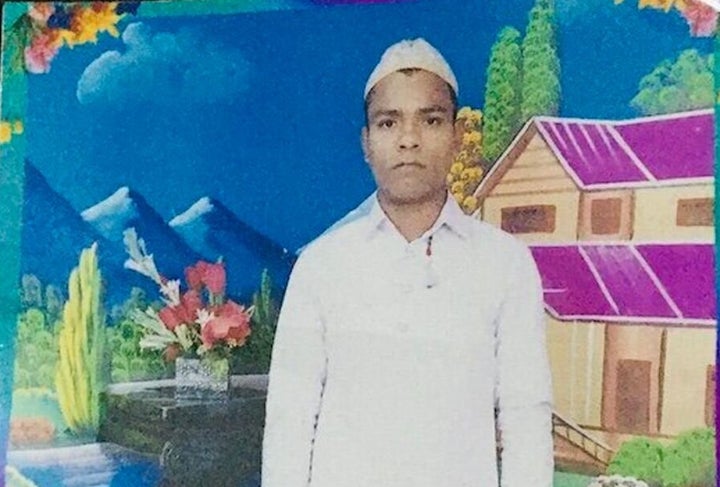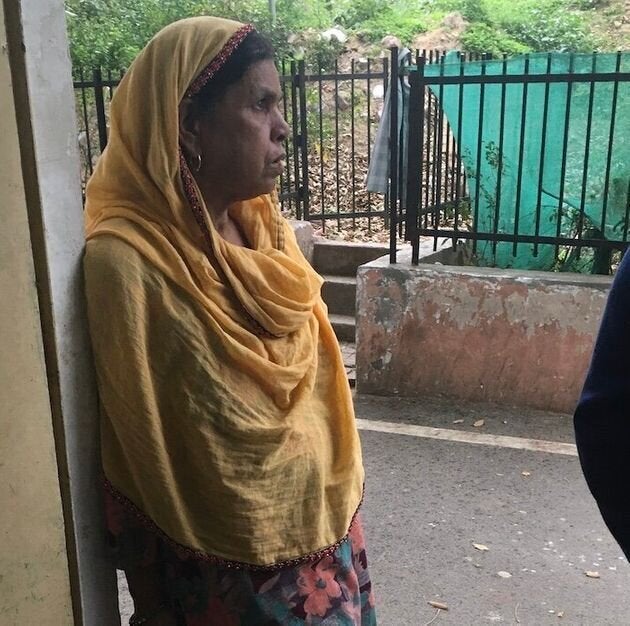
NEW DELHI — The Delhi Police’s First Information Report into one the most controversial deaths in the 2020 Delhi Riots omits any reference to the police’s alleged role in the incident.
23-year-old Faizan died in February this year, days after he was violently assaulted by uniformed policemen and forced to sing the national anthem.
A video of the incident sparked outrage after it went viral online and was also carried by several news outlets.
Yet the First Information Report registered by the Bhajanpura Police station makes no mention of the clearly documented video footage of the police assaulting Faizan; contradicts on-record police statements that Faizan was in police custody following his assault, and claims that Faizan died after he went missing from the Guru Tegh Bahadur hospital in northeast Delhi.
Three months and a half months after his death, Faizan’s family is yet to get a copy of the autopsy conducted on his corpse. Meanwhile, key witnesses in the case told HuffPost India that police officers were putting pressure on them to change their statements.
Kismatun, Faizan’s 61-year-old mother, told HuffPost India that the local police had asked her to change statements in which she placed the onus of Faizan’s death on the police for first assaulting her son in the streets, and then denying him medical treatment when he was held at the Jyoti Nagar police station.
“In the first week of March they called me to Jyoti Nagar station and this time, they addressed me as mataji. A policeman told me, ‘Whoever had to go is now gone. If you change your views, you will get some aid and money’.” Kismatun told HuffPost India. “I told the policeman, I did not want any money. If they had let my child go, I would have sold our house if needed, and got him treatment.”
“If the police had allowed my injured son to go, I would have saved him,” Kisamtun said.
Deputy Commissioner of Police (Crime Branch) Rajesh Deo who is heading the probe declined to comment on whether his team had identified the uniformed policemen who are seen assaulting Faizan in the widely circulated viral video, nor did he respond to the numerous discrepancies in the initial police complaint.
“The case is pending investigation,” Deo said. “If there are any discrepancies, they will come out in further investigation.” Three months have passed since Faizan’s death, but the police are yet to file a charge-sheet in the case, without which prosecution proceedings cannot begin in court.
“This is not a blind spot or a mystery case, one without any evidence, but one in which there is clear video evidence,” said Vrinda Grover, the lawyer for Faizan’s family. “Instead of following these video leads and testimonies of eye witnesses to identify the perpetrators, the police are questioning the morality and integrity of the victims, and those who captured the videos of the assault from a distance.”
“Even during a situation of riots or disturbances, formal orders get passed on which police units will be deputed in which areas. Who those 6 to 8 policemen were who assaulted Faizan is known to the police,” Grover said. “If the police SIT who are meant to investigate this impartially are not submitting a charge-sheet even after over three months, then it shows the police is shielding those men.”
The following account, based on the FIR, interviews with witnesses and family members, and HuffPost India’s previous reporting on Faizan’s death, raises troubling questions over the Delhi police’s investigations into the week-long communal riots that swept the national capital and claimed at least 53 lives. Reams of video footage from bystanders and CCTVs have shown policemen actively participating in the violence by attacking students and bystanders and damaging public and private property.
The police have registered over 750 first information reports, filed over 88 chargesheets, and claimed that the riots are a consequence of a pre-planned conspiracy by forces aligned against the government; yet the force has been curiously silent about the violence committed by its own policemen.
Omissions in police version
If the police FIR is to be believed, on Feb 25 Head Constable Manoj Bhatti arrived at GTB hospital and was provided Faizan’s medico-legal-certificate which claimed “physical assault by mob” as stated by the patient himself. Faizan, the FIR claims, had received treatment and left GTB hospital on his own. The FIR claims the police visited Faizan’s house, but he was not at home. Later, the police learnt he had sought treatment at Lok Nayak Hospital and had died.
The police version of events makes several omissions, as per a detailed investigation by HuffPost India published in March, and eliminates the active role played by the police all together.
An eyewitness who was assaulted by the police alongside Faizan had told HuffPost India that they were bundled into a police vehicle after their assault and taken to the Guru Tegh Bahadur hospital for a round of basic first-aid, after which they were taken to the Jyoti Nagar police station.
Shailendra Tomar, the Station House Officer of Jyoti Nagar station, where Kardampuri falls, had in February, confirmed to Huffpost India that Faizan and the other men seen in the assault video were brought to the station on February 24 from GTB hospital.
Kisamtun, Faizan’s mother, said she went to the Jyoti Nagar police station to plead for her son’s release on three separate occasions: The night of February 24, the morning of February 25, and then finally the night of February 25 when the police finally allowed her to take Faizan home at about 11 PM at night.
The next morning, Kisamatun and her relatives rushed Faizan to the Lok Nayak Hospital after his health deteriorated considerably. He died the same day.
“The police had beat my son so severely that his body turned blue by the time they released him from Jyoti Nagar police station on the night of February 25,” Kisamtun, Faizan’s 61-year old mother told HuffPost India in an interview soon after Faizan’s death. “The policemen had put batons inside his throat and he could not swallow or eat when he got him home. Even his fingers were swollen and broken.”
Crucially, the family was unable to get any official documentation regarding Faizan’s death — neither his medico-legal-certificate from when he was first brought to GTB hospital, nor his autopsy. In fact, his body was not released for three days as police officials at the neighbouring police stations of Bhajanpura and Jyoti Nagar argued over who had jurisdiction over his case.
Three months into the case, Faizan’s family say members of the Crime Branch have interviewed them, even as the local police force has sought to silence their testimonies.

“I told the investigators that I went to Jyoti Nagar station on the night of February 24. There, a policeman confirmed to me that Faizan was in the station lock-up,” Kismatun recounted. “But the station staff were rude and dismissive. They threatened me, ‘Go, get lost, we will lock you in too’.”
“I went again the next morning but they would not respond to me. Late at around 11 at night of February 25, when his condition kept getting worse and he had started vomiting, the SHO told my neighbours to tell me to take him back. I and relatives of two men who had also been assaulted by the police requested a neighbour to drive us in an auto to the station and six of us returned together from the station.” Kismatun said.
As mentioned earlier, the police subsequently called Kismatun and asked her to change her statement. She isn’t the only witness the police have sought to influence.
“The police are interrogating the person who shot the second video which provides an aerial shot of the police assaulting Faizan and four men next to the Kardampuri mohalla clinic and corroborates the incident,” said a member of Faizan’s family, referring to the fact that there are three separate videos of the police assaulting Faizan. “After they were questioned, the family approached us in April and told us they were terrified. They asked if we had registered a police case against those who shot the video.”
The relative said the police intimidated the person who shot the video by insinuating that he was a rioteer too.
“Similarly, the police have been questioning Faizan’s co-workers about his reputation, whether he took part in protests against the citizenship law or not, and so on,” the relative said.
One of Faizan’s former co-workers at the poultry shop, where Faizan worked shortly prior to his death, confirmed that the police had interrogated him about Faizan’s involvement in protests against the Citizenship Amendment Act (CAA), Modi government’s controversial new citizenship law that critics say discriminates against Muslims.
“The police asked me what kind of boy Faizan was, was he participating in CAA protests, had he gone to work that day,” said Qureshi. “I told them I had dropped him at the circular road as per usual at 2:30 pm on February 24. He had come to work every day in the weeks prior to his death, we left home at 6am for Ghazipur and usually returned by 3 or 4 pm.”
One of the men who was in lock-up with Faizan before his death said his relatives were being questioned by the police as well.
“The police have been making enquiries from my relatives on how I am related to them, what they think of me, do I keep bad company, was I up to any mischief and rioting. I told my relatives to speak freely ― when I have done no wrong, why should I be scared?” said the young man who remained bed-ridden for weeks after he was assaulted on February 24.
He recounted that the police had assaulted him, Faizan and three others around 4 pm on February 24.
“Women from Kardampuri had organized a peaceful sit-in protest for over a month. That day, someone shouted that a fire had started on the main road and there was chaos,” the eyewitness recounted. “When I got there, it was a stampede-like situation. I fell and policemen caught me, beat me and dragged me till the mohalla clinic till my skin peeled off. Four men lay in a heap near the clinic and I was the fifth. I thought I was going to die that day.”
He continued: “They were in police uniforms, and they beat us and threatened us to sing the national anthem, and taunted us to chant ‘Azaadi’. They were shooting a video making us sing, and that video got leaked by one of them. One of them even threatened us openly ‘Even if you die, nothing will happen to us, and it will be written off as a riot case’.”
He reiterated that Faizan was kept in the lock-up at Jyoti Nagar after being brutally assaulted by the police, and reiterated the timeline corroborated by Kismatun, and the other witnesses in the case.
“The policemen took us to GTB hospital, and then locked us at the Jyoti Nagar station,” he said. “Faizan was asking for water. He was vomiting. We spent February 24 night in the lock-up. We were so badly injured, we could not stand up on our own. Some held Faizan and then me to even go to the toilet. We needed treatment.”
The men were finally released on February 25, the eyewitness concluded.
“The Crime Branch officials tried to ask me many indirect questions on my interest and involvement in protests, but this is the simple sequence of events which I have stated to them as well,” the witness said.